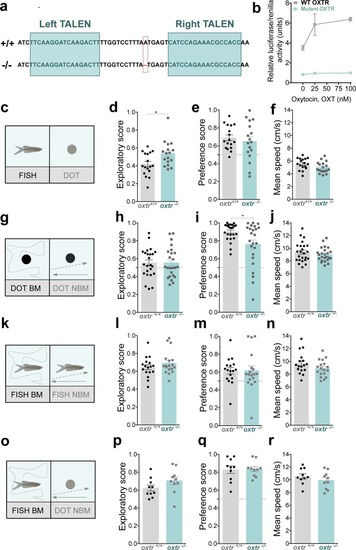
Oxytocin signaling is differently involved in the perception of biological motion and conspecific form. (a) Generation of germline transmitting oxtr mutant. TALEN sites targeting the 1st exon of the oxtr gene. Single bp mutation generates a truncated receptor. (b) Different concentrations of synthetic isotocin, also known as oxytocin in fish literature, increased cAMP reporter activity of the WT-transfected OXTR, but not the mutant. (c) WT (oxtr(+/+)) and oxtr mutant (oxtr(−/−)) fish are allowed to choose between a static fish image (FISH) vs. a static dot (DOT). (d) Comparison of exploratory score between oxtr(+/+) (grey bars, n = 17) and oxtr(−/−) (cyan bars, n = 16). (e) Comparison of preference score towards social cues between oxtr(+/+) (grey bars, n = 17) and oxtr(−/−) (cyan bars, n = 16). (f) Comparison of mean speed between oxtr(+/+) (grey bars, n = 17) and oxtr(−/−) (cyan bars, n = 16). (g) Fish oxtr(+/+) and oxtr(−/−) are allowed to choose between a dot moving with biological motion (DOT BM) vs. a non-biological motion (DOT NBM). (h) Comparison of exploratory score between oxtr(+/+) (grey bars, n = 24) and oxtr(−/−) (cyan bars, n = 24). (i) Comparison of preference score towards social cues between oxtr(+/+) (grey bars, n = 24) and oxtr(−/−) (cyan bars, n = 24). (j) Comparison of mean speed between oxtr(+/+) (grey bars, n = 24) and oxtr(−/−) (cyan bars, n = 24). (k) Fish oxtr(+/+) and oxtr(−/−) are allowed to choose between a fish moving with biological motion (FISH BM) vs. a fish image moving with non-biological motion (FISH NBM). (l) Comparison of exploratory score between oxtr(+/+) (grey bars, n = 17) and oxtr(−/−) (cyan bars, n = 18). (m) Comparison of preference score towards social cues between oxtr(+/+) (grey bars, n = 17) and oxtr(−/−) (cyan bars, n = 18). (n) Comparison of mean speed between oxtr(+/+) (grey bars, n = 17) and oxtr(−/−) (cyan bars, n = 18). (o) Fish oxtr(+/+) and oxtr(−/−) are allowed to choose between a fish moving with biological motion (FISH BM) vs. a dot with non-biological motion (DOT NBM). (p) Comparison of exploratory score between oxtr(+/+) (grey bars, n = 10) and oxtr(−/−) (cyan bars, n = 10). (q) Comparison of preference score towards social cues between oxtr(+/+) (grey bars, n = 10) and oxtr(−/−) (cyan bars, n = 10). (r) Comparison of mean speed between oxtr(+/+) (grey bars, n = 10) and oxtr(−/−) (cyan bars, n = 10). Error bars indicate SEM. *P < 0.05.
|

